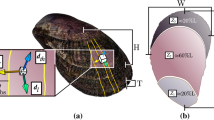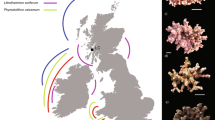Abstract
Diatoms are the major contributors to phytoplankton blooms in lakes and in the sea and hence are central in aquatic ecosystems and the global carbon cycle1. All free-living diatoms differ from other phytoplankton groups in having silicified cell walls in the form of two ‘shells’ (the frustule) of manifold shape and intricate architecture2 whose function and role, if any, in contributing to the evolutionary success of diatoms is under debate3,4,5. We explored the defence potential of the frustules as armour against predators by measuring their strength. Real and virtual loading tests (using calibrated glass microneedles and finite element analysis) were performed on centric and pennate diatom cells. Here we show that the frustules are remarkably strong by virtue of their architecture and the material properties of the diatom silica. We conclude that diatom frustules have evolved as mechanical protection for the cells because exceptional force is required to break them. The evolutionary arms race between diatoms and their specialized predators will have had considerable influence in structuring pelagic food webs and biogeochemical cycles.
This is a preview of subscription content, access via your institution
Access options
Subscribe to this journal
Receive 51 print issues and online access
$199.00 per year
only $3.90 per issue
Buy this article
- Purchase on Springer Link
- Instant access to full article PDF
Prices may be subject to local taxes which are calculated during checkout



Similar content being viewed by others
References
Smetacek, V. Diatoms and the ocean carbon cycle. Protist 150, 25–32 (1999)
Round, F. E., Crawford, R. M. & Mann, D. G. The Diatoms: Biology and Morphology of the Genera (Cambridge Univ. Press, Cambridge, UK, 1990)
Tilman, D. & Kilham, P.. Sinking in freshwater phytoplankton: Some ecological implications of cell nutrient status and physical mixing processes. Limnol. Oceanogr. 21, 409–417 (1976)
Hale, M. S. & Mitchell, J. G. Functional morphology of diatom frustule microstructures: hydrodynamic control of Brownian particle diffusion and advection. Aquat. Microb. Ecol. 24, 287–295 (2001)
Milligan, A. J. & Morel, F. M. M. A proton buffering role for silica in diatoms. Science 297, 1848–1850 (2002)
Gersonde, R. & Harwood, D. M. Lower Cretaceous diatoms from ODP Leg 113 site 693 (Weddell Sea). Part 1: vegetative cells. Proc. ODP Sci. Res. 113, 365–402 (1990)
Burkhardt, B. & Bach, K. Diatoms 1—Shells in Nature and Technics (Cramer, Braunschweig, 1984)
Ehrenberg, C. G. Die Infusionsthierchen als vollkommene Organismen. Ein Blick in das tiefere organische Leben der Natur (Leopold Voss, Leipzig, 1838)
Smetacek, V. A watery arms race. Nature 411, 745 (2001)
Round, F. E. The problem of reduction of cell size during diatom cell division. Nova Hedwigia 23, 291–303 (1972)
Verity, P. G. & Smetacek, V. Organism life cycles, predation, and the structure of marine pelagic ecosystems. Mar. Ecol. Prog. Ser. 130, 277–293 (1996)
Ashman, R. B., Cowin, S. C., Van Buskirk, W. C. & Rice, J. C. A continuous wave technique for the measurement of the elastic properties of cortical bone. J. Biomech. 17, 349–361 (1984)
Willems, G., Lambrechts, P., Braem, M., Celis, J. P. & Vanherle, G. A classification of dental composites according to their morphological and mechanical characteristics. Dent. Mater. 8, 310–319 (1992)
Kröger, N., Deutzmann, R. & Sumper, M. Polycationic peptides from diatom biosilica that direct silica nanosphere formation. Science 286, 1129–1132 (1999)
Fortin, D. & Vargas, M. A. The spectrum of composites: new techniques and materials. J. Am. Dental Assoc. 131, 26–30 (2000)
Crawford, S. A., Higgins, M. J., Mulvaney, P. & Wetherbee, R. Nanostructure of the diatom frustule as revealed by atomic force and scanning electron microscopy. J. Phycol. 37, 543–554 (2001)
Thompson, J. B. et al. Bone indentation recovery time correlates with bond reforming time. Nature 414, 773–776 (2001)
Sullivan, B. K., Miller, C. B., Peterson, W. T. & Soeldner, A. H. A scanning electron microscopy study of the mandibular morphology of boreal copepods. Mar. Biol. 30, 175–182 (1975)
Suh, H. L. The gastric mill of euphausiid crustaceans: a comparison of eleven species. Hydrobiologia 321, 235–244 (1996)
Fowler, S. W. & Fisher, N. S. Viability of marine phytoplankton in zooplankton fecal pellets. Deep-Sea Res. 30, 963–969 (1983)
Weis-Fogh, T. & Alexander, R. M. in Scale Effects in Animal Locomotion (ed. Pedley, T. J.) 511–525 (Academic, London, 1977)
Atkinson, A. Omnivory and feeding selectivity in five copepod species during spring in the Bellingshausen Sea, Antarctica. ICES J. Mar. Sci. 52, 385–396 (1995)
Smetacek, V. The annual cycle of protozooplankton in the Kiel Bight. Mar. Biol. 63, 1–11 (1981)
Jacobson, D. M. A brief history of dinoflagellate feeding research. J. Eukaryot. Microbiol. 46, 376–381 (1999)
Haeckel, E. Kunstformen der Natur (Bibliographisches Institut, Leipzig/Vienna, 1904)
Cifuentes, A. O. & Kalbag, A. A performance study of tetrahedral and hexahedral elements in 3-D finite element structural analysis. Finite Elements Anal. Des. 12, 313–318 (1992)
Steucek, G. & Schmid, A.-M. M. in Beiträge zum 1. internationalen Symposion des Sonderforschungsbereiches 230 Natürliche Konstruktionen, Leichtbau in Architektur und Natur Teil 2 194–203 (Sprint-Druck GmbH, Stuttgart, 1989)
Acknowledgements
We thank F. Hinz and R. Crawford for the SEM image of F. kerguelensis. U. Riebesell, D. Wolf-Gladrow, U. Bathmann and R. Crawford provided comments.
Author information
Authors and Affiliations
Corresponding author
Ethics declarations
Competing interests
The authors declare that they have no competing financial interests.
Rights and permissions
About this article
Cite this article
Hamm, C., Merkel, R., Springer, O. et al. Architecture and material properties of diatom shells provide effective mechanical protection. Nature 421, 841–843 (2003). https://doi.org/10.1038/nature01416
Received:
Accepted:
Issue Date:
DOI: https://doi.org/10.1038/nature01416
This article is cited by
-
Multiple-pathways light modulation in Pleurosigma strigosum bi-raphid diatom
Scientific Reports (2024)
-
Assessing the effects of silicate addition on phytoplankton composition and copepod production in an inorganic fertilization system
Aquaculture International (2024)
-
Geotechnical characterization of the diatomaceous silty soil in Walvis Bay, Namibia: mechanical properties and interpretations of CPTu records
Bulletin of Engineering Geology and the Environment (2024)
-
Genome analysis of Parmales, the sister group of diatoms, reveals the evolutionary specialization of diatoms from phago-mixotrophs to photoautotrophs
Communications Biology (2023)
-
Revealing the static and dynamic nanomechanical properties of diatom frustules—Nature's glass lace
Scientific Reports (2023)
Comments
By submitting a comment you agree to abide by our Terms and Community Guidelines. If you find something abusive or that does not comply with our terms or guidelines please flag it as inappropriate.



